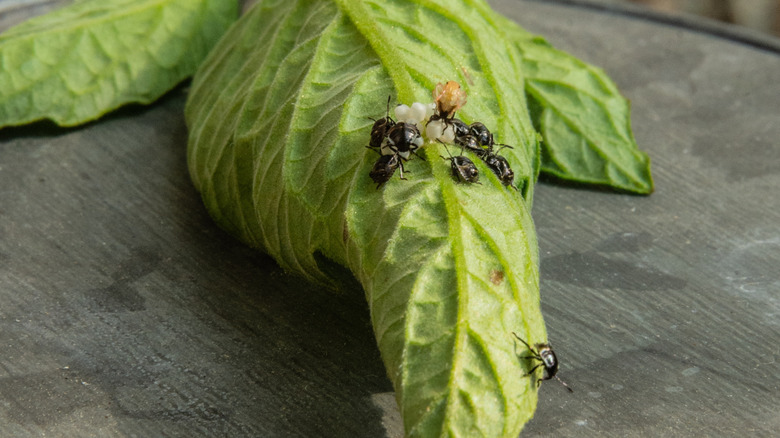Why The Tiny Black Bugs On Your Tomato Plants Are A Big Deal (And What To Do About It)
So you've successfully germinated your tomato seeds — after you've carefully researched appropriate potting medium, light, and water needs and tended the tiny seedlings accordingly, they're finally ready to be transplanted outdoors to their permanent home. In the days that follow the big move, you start to notice a few tiny black beetles on the young plants. They have a funny habit of jumping when startled. As time passes, the leaves on your tomato plants begin to resemble Swiss cheese, full of tiny holes. Unfortunately, your tomato plants likely have an infestation of flea beetles, and you'll need to take prompt action to ensure your plants' survival. Through a combination of chemical treatments and smart cultural care, you have a good chance of beating the bugs.
Flea beetles' colors may vary — many are black, but they may also be brown, bronze, or other metallic shades, and may be striped — but one surefire way to identify them is by their large, almost cricket-like back legs. These enable them to jump like fleas, hence the name. Round holes in the leaves of your tomatoes can indicate adult feeding activity. Below the soil, however, their white, worm-like larvae may be feeding on the roots. Young plants are at the greatest risk of significant damage from flea beetles' feeding. While adult plants are likely strong enough to survive direct damage, there is a risk that flea beetles can spread plant diseases and blight from plant to plant, so it's worth getting rid of them regardless.
How to get rid of flea beetles
Before you reach for the insecticides, there are a few home remedies you might try first. In a spray bottle, combine water and isopropyl alcohol in a ratio of about 5:2, along with a tablespoon or so of dish liquid. Just make sure to test the solution on one or two leaves overnight and check in the morning to make sure your plants don't experience any damage before you completely douse your tomato crop. You might be able to use neem oil to eliminate flea beetles. Dusting the leaves of your tomato plants with talcum powder may also discourage adult beetles from feeding there. If you're treating young plants, make sure to reapply these control measures as vulnerable new growth appears.
If you're nervous about the possibility of flea beetles — or you've dealt with them before and want to prevent another invasion — there are a few gardening practices you can try that might discourage the beetles from colonizing your tomato plants in the first place. Tilling the soil in the fall and removing any existing plant debris can leave last year's adult beetles with nowhere to overwinter. The following spring, delay planting by a few weeks if possible so any emerging beetles will find nothing to snack on. You can also use trap crops, which are crops planted earlier that serve as tempting distractions to draw the beetles away from your tomatoes. Radishes and nasturtium are a couple of good options.

